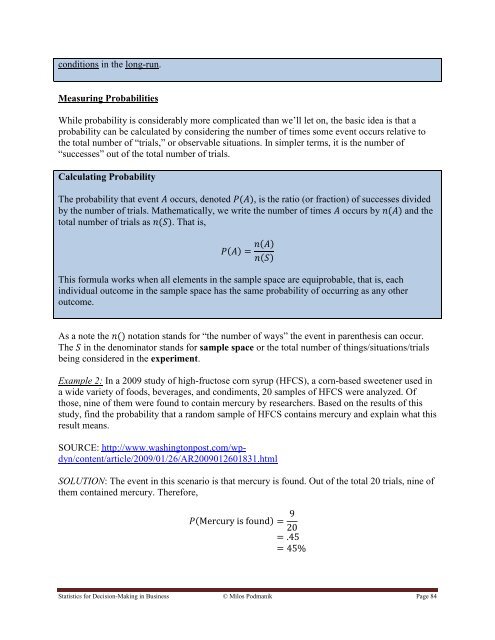Statistics for Decision- Making in Business - Maricopa Community ...
Statistics for Decision- Making in Business - Maricopa Community ...
Statistics for Decision- Making in Business - Maricopa Community ...
Create successful ePaper yourself
Turn your PDF publications into a flip-book with our unique Google optimized e-Paper software.
conditions <strong>in</strong> the long-run.<br />
Measur<strong>in</strong>g Probabilities<br />
While probability is considerably more complicated than we‟ll let on, the basic idea is that a<br />
probability can be calculated by consider<strong>in</strong>g the number of times some event occurs relative to<br />
the total number of “trials,” or observable situations. In simpler terms, it is the number of<br />
“successes” out of the total number of trials.<br />
Calculat<strong>in</strong>g Probability<br />
The probability that event occurs, denoted ( ), is the ratio (or fraction) of successes divided<br />
by the number of trials. Mathematically, we write the number of times occurs by ( ) and the<br />
total number of trials as ( ). That is,<br />
( )<br />
( )<br />
( )<br />
This <strong>for</strong>mula works when all elements <strong>in</strong> the sample space are equiprobable, that is, each<br />
<strong>in</strong>dividual outcome <strong>in</strong> the sample space has the same probability of occurr<strong>in</strong>g as any other<br />
outcome.<br />
As a note the () notation stands <strong>for</strong> “the number of ways” the event <strong>in</strong> parenthesis can occur.<br />
The <strong>in</strong> the denom<strong>in</strong>ator stands <strong>for</strong> sample space or the total number of th<strong>in</strong>gs/situations/trials<br />
be<strong>in</strong>g considered <strong>in</strong> the experiment.<br />
Example 2: In a 2009 study of high-fructose corn syrup (HFCS), a corn-based sweetener used <strong>in</strong><br />
a wide variety of foods, beverages, and condiments, 20 samples of HFCS were analyzed. Of<br />
those, n<strong>in</strong>e of them were found to conta<strong>in</strong> mercury by researchers. Based on the results of this<br />
study, f<strong>in</strong>d the probability that a random sample of HFCS conta<strong>in</strong>s mercury and expla<strong>in</strong> what this<br />
result means.<br />
SOURCE: http://www.wash<strong>in</strong>gtonpost.com/wpdyn/content/article/2009/01/26/AR2009012601831.html<br />
SOLUTION: The event <strong>in</strong> this scenario is that mercury is found. Out of the total 20 trials, n<strong>in</strong>e of<br />
them conta<strong>in</strong>ed mercury. There<strong>for</strong>e,<br />
( )<br />
<strong>Statistics</strong> <strong>for</strong> <strong>Decision</strong>-<strong>Mak<strong>in</strong>g</strong> <strong>in</strong> Bus<strong>in</strong>ess © Milos Podmanik Page 84
















